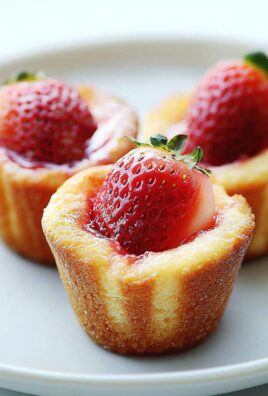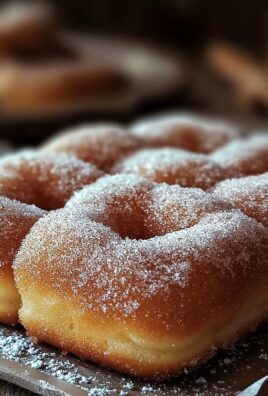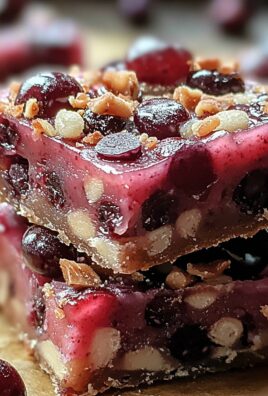Homemade Pastry Cream, oh, the very words conjure images of delectable desserts and sweet, creamy perfection! Have you ever bitten into a perfectly filled éclair or a delicate fruit tart and wondered how that luscious, vanilla-infused filling was made? Well, wonder no more! I’m about to share a recipe that will empower you to create this classic confection in your very own kitchen.
Pastry cream, also known as crème pâtissière, boasts a rich history, deeply rooted in French culinary tradition. For centuries, it has been a cornerstone of French patisserie, lending its velvety texture and delicate flavor to countless desserts. It’s a testament to the power of simple ingredients transformed into something truly extraordinary.
What makes homemade pastry cream so irresistible? It’s the symphony of flavors and textures the smooth, creamy base, the subtle sweetness, and the hint of vanilla that dances on your tongue. Beyond its exquisite taste, pastry cream is incredibly versatile. It’s the star of éclairs, cream puffs, tarts, and trifles, and can even be used as a filling for cakes or as a decadent topping for fruit. Its adaptability and delightful flavor profile are why it remains a beloved dessert component worldwide. So, let’s embark on this culinary adventure together, and I’ll show you how to make this delightful treat!
Ingredients:
- 1 cup (240ml) whole milk
- 1 cup (240ml) heavy cream
- 1 vanilla bean, split lengthwise and seeds scraped (or 1 teaspoon vanilla extract)
- 6 large egg yolks
- ¾ cup (150g) granulated sugar
- ¼ cup (30g) cornstarch
- 2 tablespoons (28g) unsalted butter, cut into pieces
- Pinch of salt
Infusing the Cream
Okay, let’s get started! The first step is to infuse our milk and cream with that beautiful vanilla flavor. This is what really elevates this pastry cream from good to absolutely divine. Don’t skip this step!
- In a medium saucepan, combine the whole milk and heavy cream.
- If using a vanilla bean, scrape the seeds into the milk and cream mixture. Add the pod as well. This will give you the most intense vanilla flavor. If you’re using vanilla extract, hold off on adding it until the end.
- Place the saucepan over medium heat and bring the mixture to a simmer. You’ll see small bubbles forming around the edges. Be careful not to let it boil! Boiling can scald the milk and affect the final flavor.
- Once simmering, remove the saucepan from the heat and let it steep for at least 30 minutes. This allows the vanilla flavor to fully infuse into the cream. The longer it steeps, the more flavorful your pastry cream will be. I sometimes let it steep for an hour!
- After steeping, remove the vanilla bean pod (if using) and discard it. You’ve extracted all its goodness!
Preparing the Egg Yolk Mixture
While the cream is infusing, let’s get the egg yolk mixture ready. This is where the magic happens! We’ll be creating a custard base that will thicken beautifully when combined with the hot cream.
- In a medium bowl, whisk together the egg yolks and granulated sugar until the mixture is pale yellow and slightly thickened. This usually takes about 2-3 minutes. The sugar helps to break down the egg yolks and prevent them from scrambling later.
- Add the cornstarch to the egg yolk mixture and whisk until completely smooth. Make sure there are no lumps of cornstarch remaining. Cornstarch is our thickening agent, so it’s important to incorporate it properly.
Tempering the Egg Yolks
This is a crucial step! Tempering the egg yolks prevents them from scrambling when you add the hot cream. We’re essentially slowly raising the temperature of the egg yolks so they can handle the heat without curdling.
- Gradually pour about ? of the hot cream mixture into the egg yolk mixture, whisking constantly and vigorously. This is important! You need to keep the egg yolks moving to prevent them from cooking too quickly.
- Continue to whisk until the mixture is smooth and well combined.
- Pour the tempered egg yolk mixture back into the saucepan with the remaining hot cream.
Cooking the Pastry Cream
Now comes the fun part! We’re going to cook the mixture until it thickens into a luscious, creamy pastry cream. This requires patience and constant stirring, but the results are so worth it!
- Place the saucepan over medium heat and cook, stirring constantly with a whisk, until the pastry cream thickens. This will take about 5-10 minutes.
- At first, the mixture will seem thin and watery. Don’t worry! Just keep stirring.
- As the mixture heats up, you’ll notice it starting to thicken. Keep stirring vigorously, making sure to scrape the bottom and sides of the saucepan to prevent sticking and burning.
- The pastry cream is ready when it’s thick enough to coat the back of a spoon and leaves a clear line when you run your finger through it. You should also see a few bubbles erupting on the surface.
- Remove the saucepan from the heat.
Finishing Touches
Almost there! Now we’re going to add the butter and vanilla extract (if you didn’t use a vanilla bean) to enrich the pastry cream and give it that final touch of flavor.
- Stir in the butter until it’s completely melted and incorporated into the pastry cream. The butter adds richness and shine.
- If you’re using vanilla extract, stir it in now.
- Add a pinch of salt to balance the sweetness and enhance the flavors.
Cooling and Storing
Proper cooling is essential to prevent a skin from forming on the surface of the pastry cream. Here’s how to do it:
- Pour the pastry cream into a clean bowl.
- Place a piece of plastic wrap directly on the surface of the pastry cream. This prevents a skin from forming. Make sure the plastic wrap is touching the entire surface.
- Refrigerate the pastry cream for at least 2 hours, or preferably overnight, to allow it to cool completely and thicken further.
Using Your Pastry Cream
Now that you have a beautiful batch of homemade pastry cream, the possibilities are endless! Here are just a few ideas:
- Filling for Cream Puffs and Eclairs: This is a classic use for pastry cream. It’s the perfect creamy filling for these delicate pastries.
- Filling for Tarts: Use it as a base for fruit tarts. Top with fresh berries, sliced peaches, or any other fruit you like.
- Layer in Cakes: Add a layer of pastry cream between cake layers for a moist and flavorful cake.
- Filling for Donuts: Inject it into donuts for a decadent treat.
- Base for Fruit Salad: Use it as a creamy base for a fruit salad.
- As a Dessert on its Own: Serve it in small cups or glasses as a simple and elegant dessert. You can top it with fresh fruit, chocolate shavings, or a sprinkle of cocoa powder.
Tips and Tricks for Perfect Pastry Cream
Here are a few extra tips to help you make the best pastry cream ever:
- Use Fresh Ingredients: Fresh eggs and high-quality dairy will make a big difference in the flavor and texture of your pastry cream.
- Don’t Overcook: Overcooked pastry cream can become grainy or lumpy. Be sure to remove it from the heat as soon as it’s thick enough.
- Strain for Extra Smoothness: For an extra smooth pastry cream, you can strain it through a fine-mesh sieve after cooking. This will remove any lumps or cooked egg particles.
- Adjust the Sweetness: If you prefer a less sweet pastry cream, you can reduce the amount of sugar slightly.
- Add Flavorings: Get creative with flavorings! You can add lemon zest, orange zest, coffee extract, or even a liqueur to customize your pastry cream.
- Preventing Lumps: The key to preventing lumps is constant stirring and proper tempering of the egg yolks. If you do get lumps, you can try whisking vigorously or using an immersion blender to smooth them out. Straining the pastry cream is also a good way to remove any lumps.
- Storage: Pastry cream is best used within 2-3 days. Store it in an airtight container in the refrigerator.
Troubleshooting
My pastry cream is too thin.
If your pastry cream is too thin, it may not have been cooked long enough. Return it to the saucepan and cook over medium heat, stirring constantly, until it thickens. Be careful not to overcook it.
My pastry cream is too thick.
If your pastry cream is too thick, you can thin it out by whisking in a little bit of milk or cream. Add the liquid gradually until you reach the desired consistency.
My pastry cream is lumpy.
If your pastry cream is lumpy, you can try whisking it vigorously or using an immersion blender to smooth it out. Straining the pastry cream through a fine-mesh sieve is also a good way to remove any lumps.
My pastry cream has a skin on top.
To prevent a skin from forming on the surface of the pastry cream, place a piece of plastic wrap directly on the surface while it’s cooling. Make sure the plastic wrap is touching the entire surface.
Enjoy your delicious homemade pastry cream! I hope you found this recipe helpful. Let me know in the comments if you have any questions or if you try it out!
Conclusion:
And there you have it! This homemade pastry cream recipe is truly a game-changer, and I wholeheartedly believe it deserves a spot in your baking repertoire. Why? Because it’s incredibly versatile, undeniably delicious, and surprisingly easy to make once you get the hang of it. Forget the store-bought stuff this version is richer, smoother, and bursting with fresh vanilla flavor that will elevate any dessert you create.
Think about it: how many times have you reached for a pre-made pastry cream, only to be disappointed by its artificial taste and gloopy texture? With this recipe, you’re in complete control of the ingredients, ensuring a final product that’s both wholesome and utterly decadent. Plus, the satisfaction of creating something so exquisite from scratch is simply unmatched.
But the real magic lies in its adaptability. This homemade pastry cream isn’t just for cream puffs and éclairs (though it’s absolutely divine in those!). Imagine using it as a filling for tarts, layering it in trifles, or even swirling it into your morning oatmeal for a touch of indulgence. For a lighter twist, try folding in some whipped cream for a delicate Chantilly cream. Or, if you’re feeling adventurous, infuse the milk with citrus zest or spices like cinnamon or cardamom for a unique flavor profile. A splash of your favorite liqueur, like rum or Grand Marnier, can also add a sophisticated touch.
Serving suggestions are endless! Use it to fill delicate macarons, spread it between layers of sponge cake for a show-stopping birthday treat, or simply spoon it into individual ramekins and top with fresh berries for an elegant dessert. You can even use it as a base for ice cream just churn it in your ice cream maker for a creamy, dreamy frozen treat.
Don’t be intimidated by the thought of making pastry cream from scratch. I know it might seem daunting at first, but I promise you, with a little patience and attention to detail, you’ll be whipping up batches of this luscious cream in no time. The key is to keep the heat low and stir constantly to prevent scorching. And remember, even if it doesn’t turn out perfectly the first time, don’t give up! Practice makes perfect, and even a slightly imperfect batch of homemade pastry cream is still better than anything you can buy in a store.
So, what are you waiting for? Gather your ingredients, put on your apron, and get ready to embark on a culinary adventure. I’m confident that this recipe will become a staple in your kitchen, and I can’t wait to hear about your creations.
I truly encourage you to try this recipe and experience the joy of making your own homemade pastry cream. Once you do, please come back and share your experience in the comments below! Let me know what variations you tried, what desserts you used it in, and any tips or tricks you discovered along the way. I’m always eager to learn from my readers and celebrate your baking successes. Happy baking!
Homemade Pastry Cream: The Ultimate Guide to Making It Perfectly
A classic, rich, and creamy pastry cream perfect for filling cream puffs, tarts, cakes, and more. Infused with vanilla for an extra touch of elegance.
Ingredients
- 1 cup (240ml) whole milk
- 1 cup (240ml) heavy cream
- 1 vanilla bean, split lengthwise and seeds scraped (or 1 teaspoon vanilla extract)
- 6 large egg yolks
- ¾ cup (150g) granulated sugar
- ¼ cup (30g) cornstarch
- 2 tablespoons (28g) unsalted butter, cut into pieces
- Pinch of salt
Instructions
- In a medium saucepan, combine the whole milk and heavy cream.
- If using a vanilla bean, scrape the seeds into the milk and cream mixture. Add the pod as well. If you’re using vanilla extract, hold off on adding it until the end.
- Place the saucepan over medium heat and bring the mixture to a simmer (small bubbles forming around the edges). Be careful not to boil.
- Once simmering, remove the saucepan from the heat and let it steep for at least 30 minutes (or up to an hour).
- After steeping, remove the vanilla bean pod (if using) and discard it.
- In a medium bowl, whisk together the egg yolks and granulated sugar until the mixture is pale yellow and slightly thickened (about 2-3 minutes).
- Add the cornstarch to the egg yolk mixture and whisk until completely smooth.
- Gradually pour about ? of the hot cream mixture into the egg yolk mixture, whisking constantly and vigorously.
- Continue to whisk until the mixture is smooth and well combined.
- Pour the tempered egg yolk mixture back into the saucepan with the remaining hot cream.
- Place the saucepan over medium heat and cook, stirring constantly with a whisk, until the pastry cream thickens (about 5-10 minutes).
- Keep stirring vigorously, making sure to scrape the bottom and sides of the saucepan to prevent sticking and burning.
- The pastry cream is ready when it’s thick enough to coat the back of a spoon and leaves a clear line when you run your finger through it. You should also see a few bubbles erupting on the surface.
- Remove the saucepan from the heat.
- Stir in the butter until it’s completely melted and incorporated into the pastry cream.
- If you’re using vanilla extract, stir it in now.
- Add a pinch of salt to balance the sweetness and enhance the flavors.
- Pour the pastry cream into a clean bowl.
- Place a piece of plastic wrap directly on the surface of the pastry cream.
- Refrigerate the pastry cream for at least 2 hours, or preferably overnight, to allow it to cool completely and thicken further.
Notes
- Use fresh, high-quality ingredients for the best flavor.
- Constant stirring is key to preventing lumps and burning.
- Tempering the egg yolks is crucial to prevent scrambling.
- Don’t overcook the pastry cream, or it may become grainy.
- For an extra smooth pastry cream, strain it through a fine-mesh sieve after cooking.
- Pastry cream is best used within 2-3 days. Store it in an airtight container in the refrigerator.





Leave a Comment